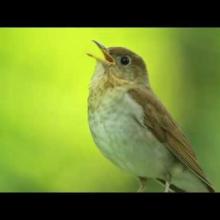

Join BirdNote tomorrow, November 30th!
Illustrator David Sibley and actor H. Jon Benjamin will face off in the bird illustration battle of the century during BirdNote's Year-end Celebration and Auction!
In some years, tawny-colored thrushes called Veeries cut their breeding season short. Researchers discovered that Veeries tend to stop breeding early in the same years that the Atlantic hurricane season is particularly severe. Surprisingly, Veeries are sometimes better at predicting hurricane conditions than computer models! Despite their forecasting prowess, though, Veeries are vulnerable to climate change.
BirdNote®
Veeries Predict Hurricanes
Written by Ariana Remmel
This is BirdNote.
[Veery song, https://macaulaylibrary.org/asset/30930861]
The whirling, flute-like song of the Veery rings through the trees of the northern United States and southern Canada during its summer breeding season. These tawny-colored thrushes raise only one brood of chicks each year. And they’ll try as many times as it takes to successfully fledge offspring.
Except that in some years, the Veeries cut their breeding season short. Birds that still haven’t raised chicks give up on breeding altogether. But why?
[Storm and wind]
With some clever data-sleuthing, researchers discovered that Veeries tend to stop breeding early in the same years that the Atlantic hurricane season is particularly severe. Instead, they prepare for their fall migration over the Gulf of Mexico to the Amazon region of South America. In fact, Veeries are sometimes better at predicting hurricane conditions than computer models! And that’s particularly intriguing to scientists, because the birds seem to forecast storms months in advance. It’s still a mystery how these songbirds became such incredible meteorologists.
As climate change increases the number and intensity of Atlantic hurricanes, many songbirds like the Veery could suffer the consequences. Not only do they have less time to breed, but their safety is compromised as they are forced to fly through fierce tempests during fall migration season.
[Veery song, https://macaulaylibrary.org/asset/30930861]
To learn more about what you can do to support migratory birds at home, start at our website: BirdNote dot ORG.
For BirdNote, I’m Ariana Remmel.
###
Senior Producer: John Kessler
Production Manager: Allison Wilson
Producer: Mark Bramhill
Associate Producer: Ellen Blackstone
Digital Producer: Conor Gearin
Bird sounds provided by The Macaulay Library of Natural Sounds at the Cornell Lab of Ornithology, Ithaca, New York. Veery ML 30930861 recorded by I. Davies.
BirdNote’s theme was composed and played by Nancy Rumbel and John Kessler.
© September 2021 BirdNote November 2023
Narrator: Ariana Remmel
VEER-01-2021-9-27 VEER-01






